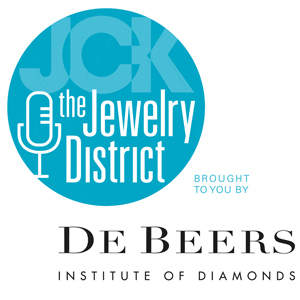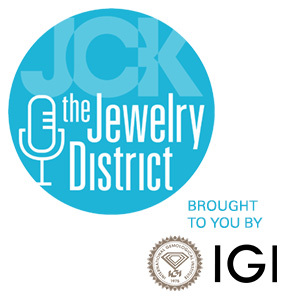
JCK editor-in-chief Victoria Gomelsky and news director Rob Bates bring listeners up to speed on trends from Tucson, where the hot colors seem to be taking their cues from the sky (think: bright blue and sunny yellow). Next, Rob breaks down the latest developments in Russian diamond sanctions, tackling still-unanswered questions, possible short-term complications, and potential long-term positives for the industry. Finally, Rob recounts what happened when a popular jewelry blogger’s Instagram account vanished, the unexpected solution she hit on to get it back, and the issues it raises.
Listen Now
Sponsored by De Beers: institute.debeers.com
Show Notes
00:51 Risks prevent travel to gold-mining region
05:47 Yellows, blues, and other news from Tucson
12:59 An update on Russian diamond sanctions
20:42 The case of the disappearing Insta
Episode Credits
Hosts: Rob Bates and Victoria Gomelsky
Producer and engineer: Natalie Chomet
Editor: Riley McCaskill
Plugs: @jckmagazine; institute.debeers.com
Show Recap
Risks prevent travel to gold-mining region
Victoria updates listeners on the cancellation of her trip to Bogotá, Colombia, to meet British jeweler Pippa Small. The two planned to travel to the Chocó province, where Pippa works with a collective of female artisanal miners to source gold ethically. Unfortunately, the remote area is also notorious for narcotics traffic, and travel advisories forced Victoria and Pippa to postpone their journey.
Victoria and Rob say the situation underscores the fact that precious materials often come from regions continually under threat, and that can have an impact even on communities dedicated to safe, responsible mining. “If we all knew where the gold in our jewels came from, and how many people touched it along the way, and what those people had to endure in order to get that gold and to sell it on, I think our minds would collectively be blown,” Victoria observes.
Yellows, blues, and other news from Tucson
Rob asks Victoria for highlights of her recent visit to Tucson for the colored gem shows. While it wasn’t a blockbuster year, she has some noteworthy takeaways. “There was a real vibe for yellow gems, particularly yellow chrysoberyl, yellow sapphires, and other gems that take on that hue,” Victoria reports. “No fewer than six high-end designers I ran into were looking for faceted chrysoberyl,” particularly lime green and yellow stones.
Vibrant blue hues captivated attendees too, says Victoria, who spied a lot of cobalt spinel from Tanzania and Vietnam. Zircon also piqued interest this year. While it’s an industry favorite for its refractive index and color variety, Victoria acknowledges that it can be a tough sell to consumers, who often confuse it with zirconia.
In Tucson, Victoria caught up with designer Stephen Webster, a show regular since 1983. “He is still buying with the exuberance and enthusiasm he had 40 years ago,” she says. The two reminisced about the designer’s groundbreaking Crystal Haze collection, introduced in the 1990s and featuring faceted clear quartz on top of other gemstones. The look was big, bold, colorful—and a huge hit with women. It was one of the first collections geared toward female self-purchasers, a phenomenon that has reshaped the industry and kept many jewelers in business for the past two decades, Victoria says.
While the high prices of 2023 are still in place thanks to lingering supply challenges from the pandemic, business overall was better than expected. “Most people are feeling pretty buoyant,” Victoria concludes.
An update on Russian diamond sanctions
After intensive research, Rob reports that though sanctions on Russian diamonds are due to start on March 1, the new rules have yet to be clarified. Importers will likely have to start providing evidence that their diamonds aren’t from Russia, but it’s not certain what that evidence will be or what penalties will be imposed for not having it, he says.
“It was very striking to me ,with so little time left, how many of these questions are still outstanding and how little answers we have,” Rob says.
Phase 2 of the sanctions is set for September and may present a huge change in business protocols. The G7’s ambitious plan is for most rough diamonds to go through Antwerp to get G7 certification, Rob says. This will require using one of the existing diamond tracing systems, such as Tracr from De Beers, he says.
Rob points out that the plan is controversial; some suspect Antwerp’s goal is to recoup market share lost from the Russian diamond ban. Others argue routing diamonds through Antwerp could prove a more secure system for the industry.
The changes ahead may well cause problems in the short term, but taking the long view, Rob sees them as a move in the right direction. “This industry has been grappling with issues of provenance going all the way back to conflict diamonds…and hasn’t really come up with an answer,” he points out. “The industry needs to know where its materials come from.”
Victoria believes traceability will become even more pivotal in the coming years, given that Gen Z and Gen Alpha care deeply about issues like ethical sourcing. She cites the focus on corporate transparency in the EU and the corresponding wave of new regulations as a potential harbinger of things to come in the U.S.
The case of the disappearing Insta
Rob fills listeners in on a mysterious incident involving well-known influencer and antique jewelry lover Becky Stone of @diamondsinthelibrary. Stone, who boasts more than 90,000 followers on Instagram and relies on the platform for her livelihood, was shocked to find herself locked out of her account recently, and was unable to get back in despite her having paid for Meta Verified, a service meant to prevent situations like the one she found herself in.
Eventually, Becky turned to her congressman, Jamie Raskin (D-Md.). Less than an hour after Raskin’s office contacted Instagram on her behalf, her account was reinstated.
What’s the larger meaning? Rob sees it as a cautionary tale, or perhaps a wake-up call: “These services are all free [and] we get very dependent on them,” he explains. “They become our life. They have all the power.” And unless you’ve got political clout, social media platforms may not feel compelled to take your concerns seriously.
Victoria agrees that the story is frustrating, though it shows “our democracy works. You can call your congressman, and one hour later your problem is solved.”
Any views expressed in this podcast do not reflect the opinion of JCK, its management, or its advertisers.
- Subscribe to the JCK News Daily
- Subscribe to the JCK Special Report
- Follow JCK on Instagram: @jckmagazine
- Follow JCK on X: @jckmagazine
- Follow JCK on Facebook: @jckmagazine





